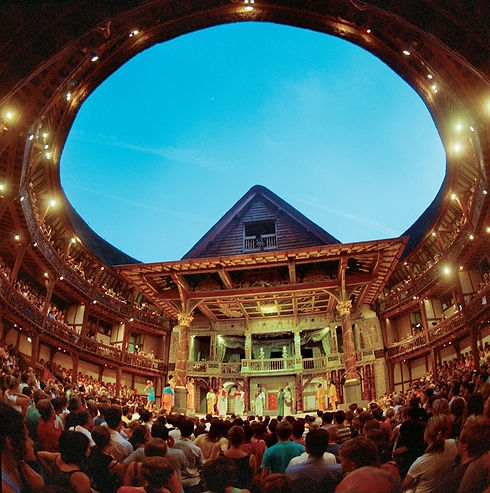
SHAKESPEARE'S GLOBE
Under that most famous of thatched roofs, I wrote research papers in response to (often brilliantly left-field) briefs from directors, producers and other personnel from the Theatre Department that influenced the style and content of productions.
I was chosen by the Head of Research to write a paper on sound and light in the Globe’s evolving artistic direction, presented in front of Sir Mark Rylance and the architectural board.
I wrote blogs and tweets posted from Globe accounts, conducted actor and audience interviews and introduced public lectures.
Photo by John Tramper.

‘AND TO THE SKIRTS OF THIS WILD WOOD HE CAME’
EXPLORING SHAKESPEARE’S FORESTS
From the travelling trees of Birnam Wood to the ‘green plot’ frequented by mechanicals, fairies and lovers, the Globe’s Summer Season is set for some iconic forest scenes. Woodlands were complex symbols on the Renaissance stage, as Sophie Merryday discusses
If Shakespearean forests went to school they’d be overachievers. They provide refuge for eloping couples, rehearsal space for players, sleeping quarters for fairies, glades for medieval tournaments and notice-boards for lovesick gentlemen to hang their (attempts at) poetry. And that’s without mentioning the leaf-clad arrivals that portend the death of a certain illegitimate Scottish King.
Given such kaleidoscopic capabilities in Shakespeare’s works, it is no surprise that forests occupied an ambiguous status in the early modern period more generally. Uncertainty was born from the contradictory definitions of ‘forest’, firstly as a natural wilderness outside of civilisation, and secondly as land that was owned and hunted by the monarch.
This liminal state between freedom and authority is highlighted by Lysander and Hermia’s journey in A Midsummer Night’s Dream. Though the pair plan to elope through the wood, it is crucially not until they reach Lysander’s aunt’s house that the ‘sharp Athenian Law/Cannot pursue us’; the forest itself is not deemed far enough from courtly control.
The lovers’ entrance into a space of enchantment and illusion, unrecognised by Athens’ authorities, tests this assumption. The forest’s alternative power structure threatens the Duke’s own position so completely that he must invent an explanation on discovering the Athenians there. ‘No doubt they rose up early to observe/The rite of May’, Theseus announces at the lovers’ sleeping feet, with all the myopic optimism of a parent ignoring the remnants of a raucous house party surrounding their comatose teenager.
The customary theatrical doubling between court authorities, Theseus and Hippolyta, and fairy king and queen, Oberon and Titania further probes the issue of authority. Their role switching reinforces the idea that the forest may permit escape from one jurisdiction, merely to replace it with another eerily similar.
Outside the play-text, the contemporary connection between the monarch and their woodland was evidently strong. Elizabeth I was still hunting her forests at 67 years old. In James I’s reign – when the country experienced an apparent ‘timber crisis’ from over-felling – a pamphlet cajoled the king to look to these ‘destroyers’, for ‘it may be conceived, no wood no Kingdome’.
Within a context of diminishing forestry, Vin Nardizzi sees the wooden structures of the outdoor playhouses as providing a comforting amalgamation of real and imaginary forests. The three different species of tree prop recorded in Henslowe’s diary (‘Baye’, ‘Gowdlen Apples’ and ‘Tantelouse’) suggest a detailed on-stage realisation of greenery. Yet beyond the singular prop, As You Like It’s reference to the ‘circle of this forest’ re-interprets the entire amphitheatre structure as a woodland.
Emerging from the natural and the man-made, and suggestive of liberation and constraint, woodlands are protean Renaissance symbols. Their grey-scale ambiguity eludes categorisation – never more succinctly defined than in King Lear’s reference to his own ‘shadowy forests’.
Sources:
Dusinberre, Juliet (ed.), As You Like It (Arden Shakespeare, 2004)
Nardizzi, Vin, ‘Shakespeare’s Globe and England’s Woods’, Shakespeare Studies, 39 (2011), 54-63
Nardizzi, Vin, Wooden Os: Shakespeare’s Theatres and England’s Trees (University of Toronto Press, 2013)
Reynolds, G. F., ‘Trees on the Stage of Shakespeare’, Modern Philology, 5.2 (1907),153–168
Saunders, Corrine J., The Forests of Medieval Romance (D.S. Brewer, 1993)
Theis, Jeffrey, Writing the Forest in Early Modern England: A Sylvan Pastoral Nation (Duquesne University Press, 2010)